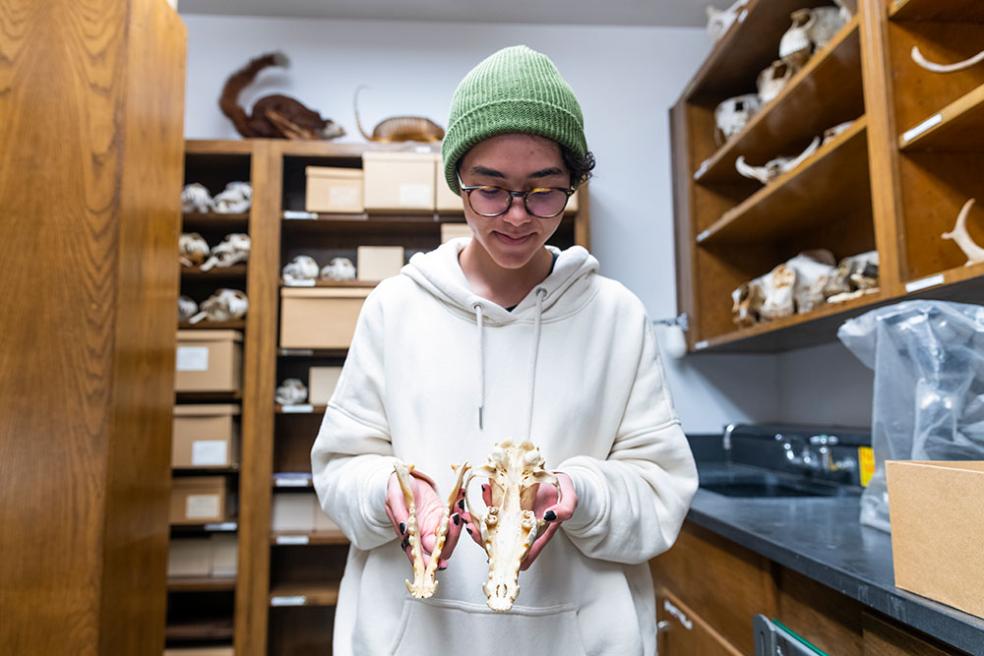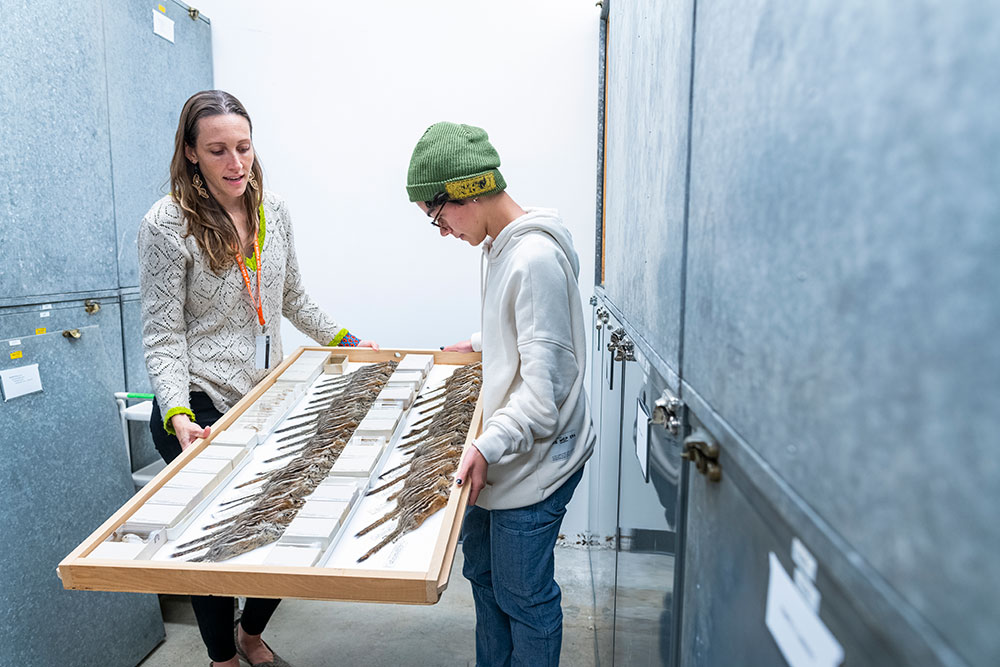
But, unless you studied animal biology, there’s a much smaller chance you’ve had reason to go into Science C. Down the unassuming corridors lies a vast, specialized collection of vertebrates: whales, snakes, bats, squirrels, and more. The specimens are carefully preserved, cataloged, and now, thanks to a National Science Foundation (NSF) grant, will be digitized and geolocated along with collections from dozens of other North American institutions.
Humboldt’s Vertebrate Museum has around 16,000 unique specimens. While a collection this size is modest, its selection of small and aquatic mammals is impressive.
“Humboldt has one of the best collections of Pacific Northwest small rodents,” says Silvia Pavan, the curator of the museum and a professor of Biological Sciences. “We have had the contributions from really good collectors of small mammals, who added specimens to our collections along the years, and our marine mammals collections are also quite good, partially because of where we are, in proximity to the coast.”

The collection is stored in crowded shelves, drawers, cabinets and tabletops throughout the building (the sperm whale skull is too large to fit inside). Pavan opens a drawer to flying squirrels--skin, fur, and bones--and turns off the overhead lights to demonstrate the recent discovery that these nocturnal rodents were found to reflect ultraviolet light.
It’s an example of how the collection helps fuel research and inform the understanding of morphology, genetics, ecology, and more on a local and global scale. A large portion of the collection is research-grade, meaning researchers can collect DNA and other information, studying the anatomy of species in the collection hands-on, accessing information about the habitat and circumstances they were collected under.
This makes digitizing the collection important. Each specimen is hand-recorded in bound books, and a previous effort uploaded the records to an incomplete computer database. But with $30,000 in funding to the RANGES project from the NSF, Pavan and her team are preparing to build a comprehensive, modern database that will be accessible online along with others along the West Coast of the U.S., Mexico, and Canada.
Tegan Alberts (‘23) is a Wildlife student who became fascinated with the Vertebrate Museum after taking a mammalogy class online.
“When I came physically to Humboldt, a friend told me about dissecting mice and I was intrigued,” says Alberts. “I really fell in love with the museum activities. This is my career now.”
Alberts and another student are being hired beginning in April with funding from the NSF grant. Alberts will focus largely on organizing and digitizing the database, while Shea Daly, another Wildlife student helping with museum activities will focus largely on inventorying the tissue collections.
The RANGES project is made up of three main phases. The first is digitizing and georeferencing the records, which requires refinement and corrections to include detailed notes on measurements, observations, and images. The georeferencing--precise information on where the specimen was taken or found–-can require some detective work. Much of the collection was built before digital georeferencing was easily accessible.
A specimen might have been recorded from an 1892 trip on the Eel River. Alberts will have to look at travel logs and other information to determine where the specimen was taken in minute detail--if it came from the right or left side of the river, for example. Distances of just several hundred feet might have important implications about a species, which can be used to look at broader ecological and evolutionary topics.
“It’s ambitious,” Pavan says. “It’s a lot of data.”
The second phase of RANGES is making all information available online for any institution to use and find, building a greater body of knowledge for researchers and instructors to draw from.
The third phase will extend the data on the collection, adding CT scans for example, so that users of the database can see layered images of bones, muscles, and organs.
While the Vertebrate Museum plays a vital role in research, it’s also an important teaching tool. Students learn to curate and prepare specimens utilizing the colony of dermestid beetles that eats away the flesh of animals, leaving only skin and bones. And they learn to use and manage resources like the museum database.

In the mammalogy classroom, Pavan has dozens of specimens out on tables and desks for students to examine. In the back of the classroom are skins and skulls of a variety of small rodents. Students are challenged to match the skulls--smaller than a pinky nail--to its skin, using techniques learned in the classroom. And while the museum’s strengths are Pacific Northwest mammals and cetaceans, the collection has specimens—including echidna, platypus, pangolin, narwhal tusks and giraffe legs— from all over the world. It gives students a physical understanding of these species and their evolution, a sense of the scale of the living creature.
Pavan says excitedly that when she was hired at Humboldt about one year ago, she was shocked. “There’s so much diversity in our teaching collections. This offers our students an amazing opportunity to learn about mammals from around the world, and about our local mammals.”